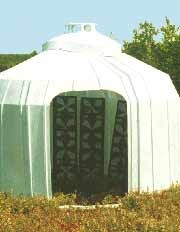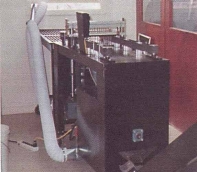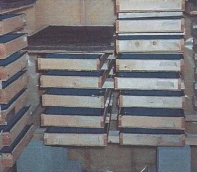INTRODUCTION
The development of alfalfa leafcutter bee management arose from the need for better pollination of the alfalfa seed crop in North America. Poor pollination and inconsistent cropping was a result of insufficient numbers of native bees, and honey bees are not an efficient option because they do not adequately pollinate alfalfa. In the 1960's when commercial scale populations of alfalfa leafcutter bees (ALBs) became available, alfalfa seed production improved dramatically. Currently, Canada produces 4 billion ALB's per year which are used to service domestic and international alfalfa seed crops as well as an increasing array of other crops.
Alfalfa Leafcutter Bees
for the Pollination of Wild Blueberries

The alfalfa leafcutter bee, one of the few commercially managed pollinators other than the honeybee, has been investigated as a pollinator of the Atlantic region wild blueberry crop since the early 1990's. They were tried in the region in order to help meet the high demand which the burgeoning wild blueberry industry has placed on beekeeping services in the Atlantic region. Attention focused on Albs because of their commercial availability, well established management guidelines, and desirable pollination attributes. Albs were used on over three hundred acres in New Brunswick in 1995, and this service is likely to undergo significant expansion in the Atlantic region in the next few years. Despite some requirements for fine-tuning the technology for use in Eastern Canada, adaptation of the Western Canadian technology for rearing and using Albs in wild blueberry fields is advancing smoothly.
YEARLY LIFE CYCLE
Unlike the honeybee, the ALB is a solitary, cavity nesting bee. Every female mates, and then collects pollen to provision her offspring. Despite its solitary nature, the bee will nest close to its neighbours. It is this tendency combined with the fact that they readily accept man-made (drilled wooden or polystyrene blocks) that allows large populations of these bees to be managed. In the spring, overwintered larvae are removed from storage and incubated at 30 C for at least 24 days until the the majority of females hatch. Male bees emerge a few days before females, and soon after females emerge mating occurs. At this point the newly emerged adults are ready for release onto the crop. After mating, each female chooses a nesting tunnel in which she constructs a thimble shaped cell from about 15 oval shaped leaf pieces. These soft, pliable leaf pieces are chosen from a variety of plants, and are cemented together by the bee's saliva and leaf juices. Each cell is provisioned with a pollen mass moistened with nectar, onto which an egg is laid just before the cell is capped with 2 to 3 leaf pieces. The next cells are laid down in a linear fashion, from the back of the tunnel to the front, until the tunnel is filled (Figure 1). The female leafcutter then caps the tunnel with a solid plug composed of many cemented leaf pieces. Under ideal field conditions a female is able to produce 12-15 cells over her life span of approximately 60 days. Cells are removed from nesting materials in late August or early September and stored in a cool, dry, mouse-free area at 5-8 C until the following spring.
ALB MANAGEMENT
Management of Alb's moves through four distinct stages: incubation, field season, bee harvest, and winter storage. If proper procedures are followed, bee numbers can be maintained or increased by up to 50% from the initial population that was introduced into the blueberry field. The first generation of bees a grower or beekeeper uses will be acquired from a Western Canadian source or an Atlantic broker. The industry is well regulated in Western Canada, where the Canadian Leafcutter Bee Cocoon Testing Centre (Brooks, Alberta) issues alfalfa leafcutter bee health certificates. Prices vary according to the quality of the cocoons and the previous season's bee production. Buyers in Atlantic Canada should be looking for bees that are free of chalk-brood (a devastating disease of Alb's) and contain low percentages of parasites, predators and other diseases. When bees are received, they are stored at 5-8 C until they are required.
Alfalfa leafcutter bees are incubated in a variety of controlled-environment chambers. The incubation of ALB cocoons results in a system which is flexible enough to allow the beekeeper/grower to synchronize bee emergence with the flowering of wild blueberries. Decades of work with Albs have allowed the development of predictable incubation calendars for rearing these bees, as summarized in Table 1.
Albs are brought in to wild blueberry fields on day 24-25 of the incubation cycle when the majority of females have hatched. Incubation trays containing bees are taken to the fields in the dark prior to sunrise. This prevents damage to bees that can occur when light, and warm temperatures, cause them to become active in the trays. Albs should be moved only when weather is favourable for foraging, since they need to find food very soon after release. A prolonged period (one week after release) without feeding will lead to bee mortality. Shelters, with nest blocks inside, are set in fields with entrances facing east to southeast to allow maximum exposure to morning light and warming. The trays are placed open into the shelters back from the entrance for protection from rain (cover photo). If possible, trays should be placed off the ground to reduce exposure to the elements. The bees emerge and orient themselves to the nest and the shelters. When the wild blueberry bloom is over, the bees can be moved to another location consisting of forage crops or wild flower meadows to improve bee reproduction. This move should be done during the night following a sunny day to ensure females are in nest tunnels since Albs often stay out in the crop when the weather turns foul.
When nest blocks are full, they are moved out of the field and held at approximately 20 C for 3 weeks to allow any immatures to complete their development and for cocoons to dry out. The cocoons are then removed from the nests and placed in cold storage at 5-8 Cfor the winter.

Table1. INCUBATION CALENDAR FOR ALFALFA LEAFCUTTER BEES |
|
| Day 1 | Cocoons laid out in trays for incubation in darkness at 30 C and 70% relative humidity, with black lights and water traps installed to monitor the degree of infestation by parasites |
| Day 7 | Dichlorvos strips (Vapona) are placed in incubator for parasite control |
| Day 8 | Bees undergo final molt into the pupal stage; this stage is particularly temperature-sensitive |
| Days 8-12 | Parasitic insects emerge |
| Day 10 | Bee pupae show pink eye colour |
| Day 12 | Bee pupae darken |
| Day 13 | If dichlorvos strips are used, remove them and air the incubator for 24-48 hours, while trying to maintain 30 C. |
| Days 14-15 | Native leafcutter bees which also nest in the tunnels emerge |
| Days 14-20 | A flexible period during which the development of the bees can be slowed to synchronize with the crop, by lowering the cocoon temperature (not the air temperature) to 11-15 C for several days. Research has shown that this period may extend to Day 22, but many beekeepers remain cautious about extending this period. |
| Day 16 | Early hatching pupae (mostly males) are completely dark |
| Days 18-19 | Males begin to emerge |
| Days 21-22 | Females begin to emerge |
| Days 23-24 | Female emergence peaks |
| Day 28 | Hatch virtually complete |
ALBS IN WILD BLUEBERRIES
Albs have been released into wild blueberry fields since the early 1990's to evaluate their suitability as wild blueberry pollinators. In areas with warm, sunny micro-climates, Albs are well suited to the climatic conditions that exist during the flowering period. In Nova Scotia studies, Albs began to fly as low as 16.3 C, began to forage at 16.8 C and averaged 88 hours of foraging over the bloom period. When released into wild blueberry fields, female Albs forage almost exclusively on the crop as shown by the high percentage of wild blueberry pollen (87%) found within cell provisions. On foraging trips, Albs visit an average of 8 flowers per minute with a pollination success rate of over 85%.
Leafcutter bees on wild blueberry generally forage within 120 metres (300 feet) from their shelters. This "stay close to home" tendency plus the bees' affinity to the blueberry flower result in high bee numbers remaining on the crop. In contrast, honey bees are often drawn off the crop to competitive bloom due to their extended flight range and low preference for wild blueberries. Alfalfa leafcutters do appear to have a higher temperature requirement than honeybees. Though the domes and nests of Albs can be bulky, their transportation is relatively easy, and overall the technology is no more bulky than that of honeybees. Albs also offer the advantage that they have a relatively flexible incubation schedule that can be synchronized to correspond to the crop's flowering. Their rearing does require the establishment of a storage area with associated climate control costs, but in northern New Brunswick, this is the case for honeybees as well. The bees are in abundant supply in Canada and have the added advantage that their sting is not painful. The fact that these bees do not provide another product than pollination can be considered an advantage or a disadvantage, depending on the need of the grower or beekeeper.
The foraging density of Albs at various distances from their shelter depends on the initial stocking rate. In research trials in Nova Scotia, Albs increased fruit set from 9% to 24% at stocking rates from 14,000 to 22,000 bees per acre. There is a strong positive relationship between the foraging density of Albs and the extent of the increase in fruit set. For more information on determining % fruit set in wild blueberry fields, please refer to Fact sheet number B.2.0 in this series.
EQUIPMENT REQUIREMENTS
Maritime wild blueberry growers have been stocking their fields with approximately 14-22,000 Albs per acre. Bees are sold in units of 10,000 live bee cocoons. Cocoons are placed in a tray for incubation. In the field, bees are housed in a shelter. Several shelter types have been designed by Western Canadians. The one most commonly used in the Atlantic region has been the polyethylene dome because of its warming capability and durability. One shelter for every 4 to 5 acres containing enough nests, usually 10 to 12, for the number of bees to be stocked, is placed on the field. One nest provides enough tunnels for each gallon of bees. The female bees lay their eggs in the tunnels within the nests. A typical arrangement is presented on the cover photo. In the early fall, bees need to be harvested/stripped from the nests for winter storage (Figure 2). Because of the expense associated with the purchase of ALB harvesting equipment, new grower/beekeepers have been working with custom services for the harvesting/stripping of bees. There are at least two such harvesters present in the maritimes. Harvested cocoons are placed into a variety of containers and stored over winter in a cool, dry, mouse-free area. This storage area must be maintained at 5-8 C and at least 50% relative humidity. Incubation chambers require heaters, humidifiers, temperature controls, electrical switches and racks for the incubation trays. They must be able to maintain a uniform temperature of 30 C and 70% relative humidity in complete darkness throughout the structure. An alarm that responds to changes in temperature is recommended. Chambers of varying levels of sophistication can be used (Figure 3). Refer to Agriculture Canada Publication 1495 for construction models (see references).

Fig. 2 ALB harvesting/stripping equipment

Fig 3. Relatively low-tech incubation chamber
A number of services are evolving for the delivery of alfalfa leafcutting bees to the maritime wild blueberry industry. These operate with some flexibility to deliver a variety of services, including total custom pollination services, as well as partial services with several ownership options. Expertise in keeping Albs in the maritime region is increasing in both the service and public sectors. For more information, please refer to the references cited here or contact your representatives at the NBDAFA.
References47 :
Javorek, S and K. Mackenzie. 1994. Alflalfa Leafcutter Bees Pollinate Lowbush Blueberry. Agriscope: Vol 4. No. 2:1- 2.
Meyer, R. and D. McBride. 1989. Alfalfa Seed Production and Leafcutting Bee Management. North Dakota Extension Service. Publication No. EB-54. 10pp.
Richards, K.W. 1984. Alfalfa leafcutter bee management in Western Canada. Publication 1495 E. Agriculture Canada (aussi disponible en français, Publication, 1495F).53pp.
Prepared by:
John Argall, P.Ag., Provincial Blueberry Specialist, New Brunswick Department of Agriculture and Rural Development;
Kenna Mackenzie, Berry Entomologist, Agriculture & Agri-food Canada, Kentville Research Station;
Steve Javorek, Biologist, Diversified Pollination Services;
Gaetan Chiasson, P.Ag., Horticulture Specialist, New Brunswick Department of Agriculture and Rural Development.
Winter 1996
